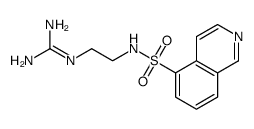HA-1004
Modify Date: 2024-01-02 20:09:57

HA-1004 structure
|
Common Name | HA-1004 | ||
|---|---|---|---|---|
| CAS Number | 91742-10-8 | Molecular Weight | 293.34 | |
| Density | N/A | Boiling Point | N/A | |
| Molecular Formula | C12H15N5O2S | Melting Point | N/A | |
| MSDS | N/A | Flash Point | N/A | |
Use of HA-1004HA-1004 is a selective inhibitor of PKA, which can inhibit lipolysis and induce vascular relaxation. HA-1004 is also a dual inhibitor of cyclic GMP-dependent protein kinase and cyclic AMP-dependent protein, and is involved in smooth muscle, second messenger, cyclic AMP and cyclic GMP regulation mechanisms. HA-1004 can be used as a vasodilator to inhibit the contraction of rabbit aortic strips, or to antagonize ERK and tyrosine hydroxylase (TH) phosphorylation in morphine abstinence rat models[1][2][3]. |
| Name | N-(2-((diaminomethylene)amino)ethyl)isoquinoline-5-sulfonamide |
|---|
| Description | HA-1004 is a selective inhibitor of PKA, which can inhibit lipolysis and induce vascular relaxation. HA-1004 is also a dual inhibitor of cyclic GMP-dependent protein kinase and cyclic AMP-dependent protein, and is involved in smooth muscle, second messenger, cyclic AMP and cyclic GMP regulation mechanisms. HA-1004 can be used as a vasodilator to inhibit the contraction of rabbit aortic strips, or to antagonize ERK and tyrosine hydroxylase (TH) phosphorylation in morphine abstinence rat models[1][2][3]. |
|---|---|
| Related Catalog | |
| Target |
cyclic GMP-dependent protein kinase, cyclic AMP-dependent protein[2] |
| References |
| Molecular Formula | C12H15N5O2S |
|---|---|
| Molecular Weight | 293.34 |
| Exact Mass | 293.09500 |
| PSA | 131.84000 |
| LogP | 2.65880 |